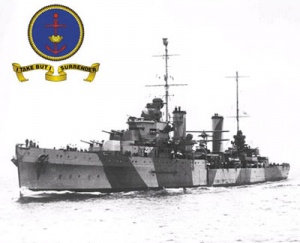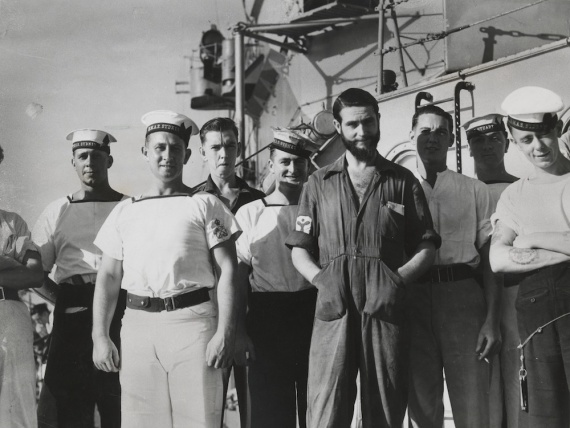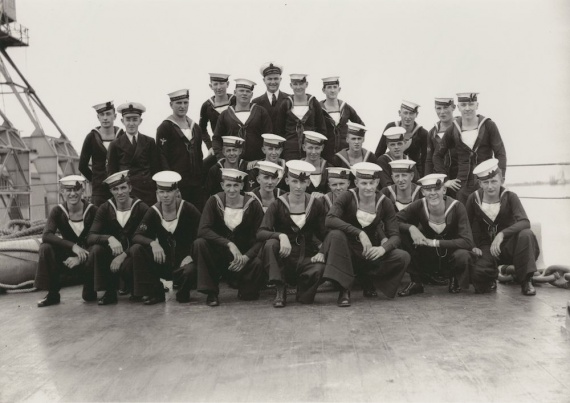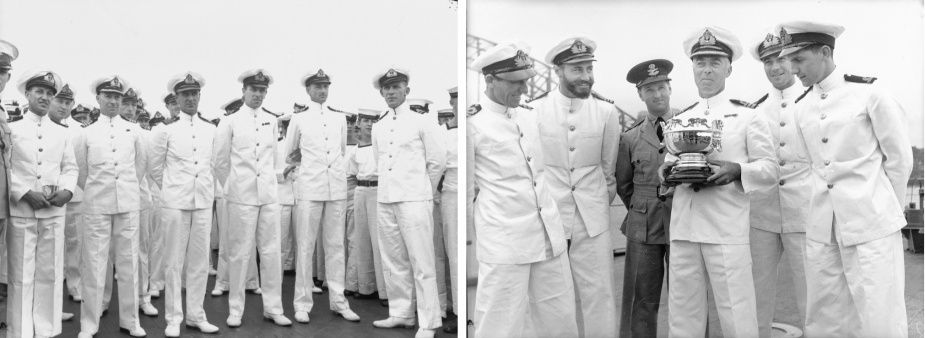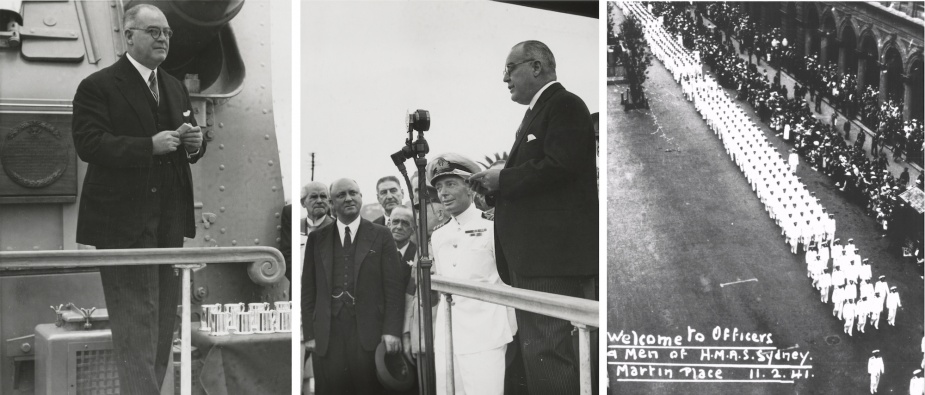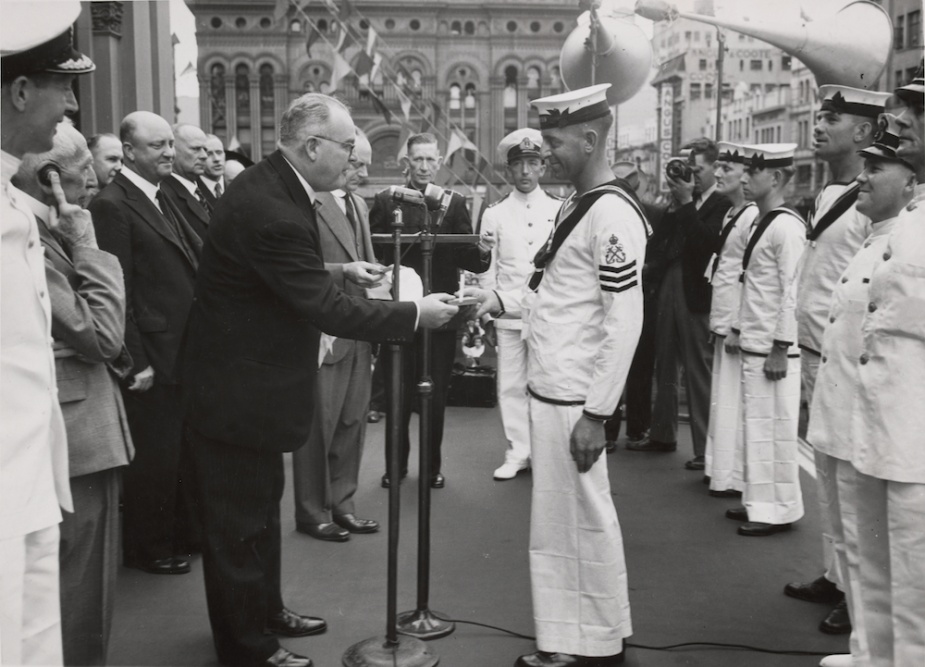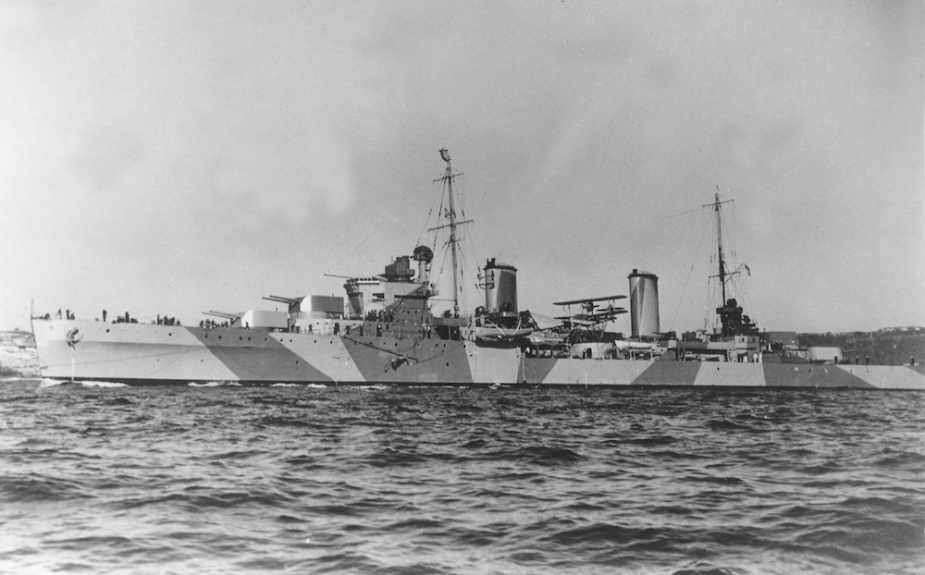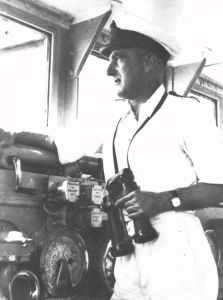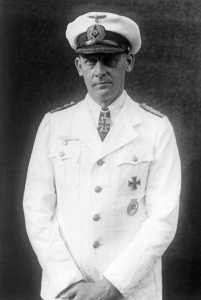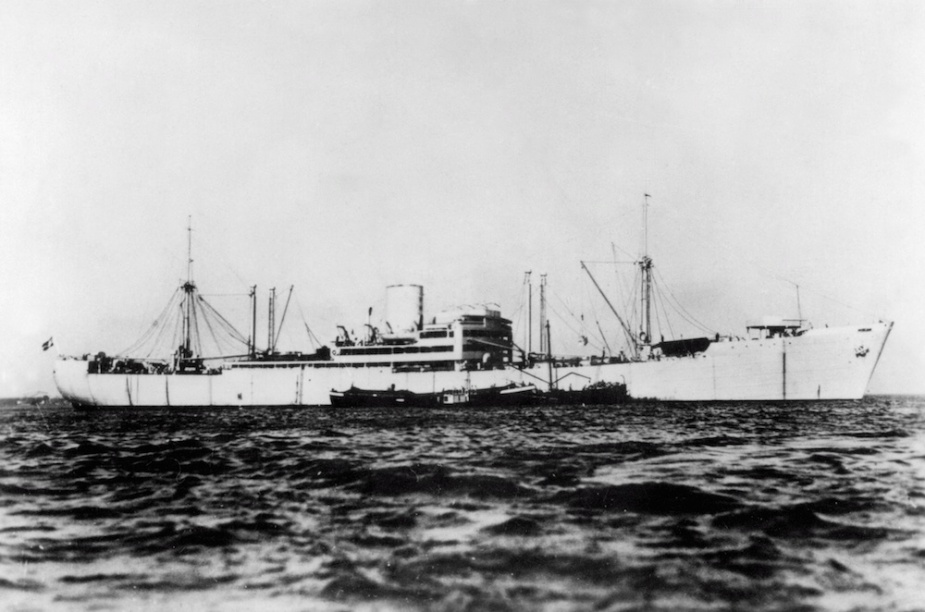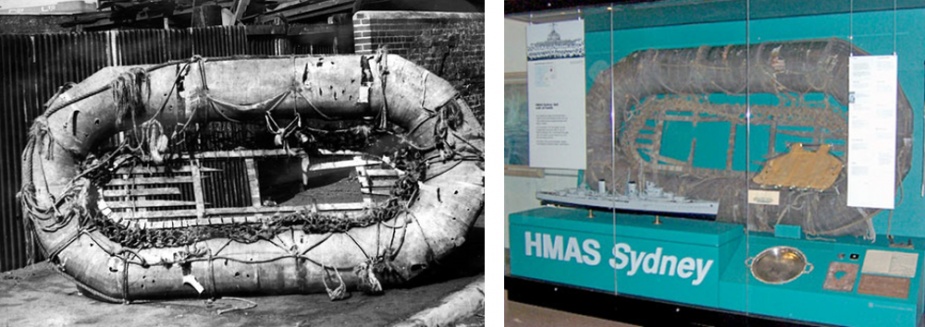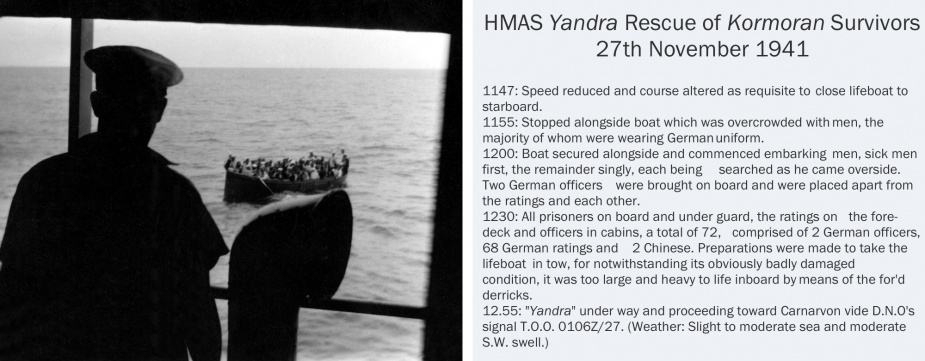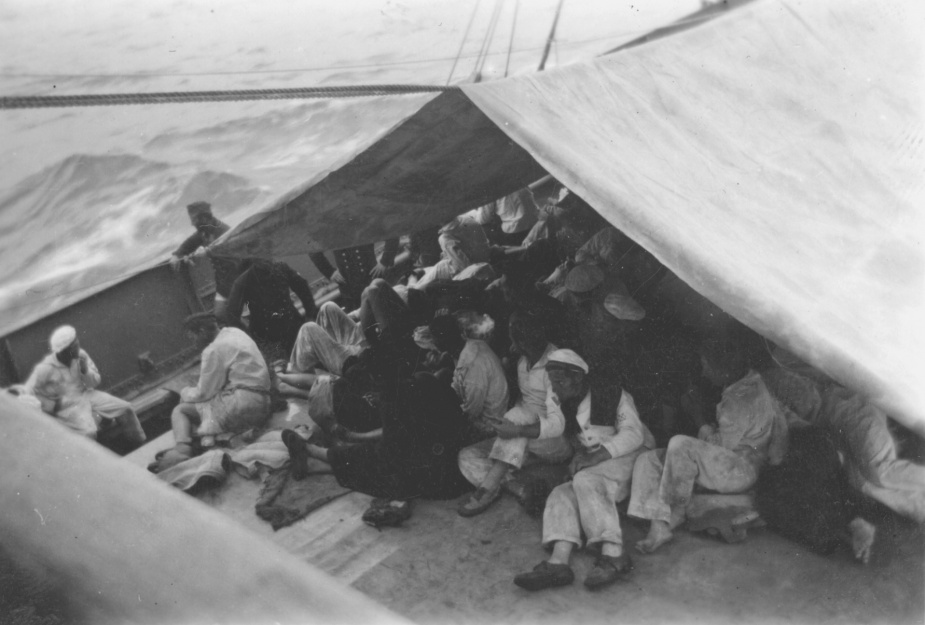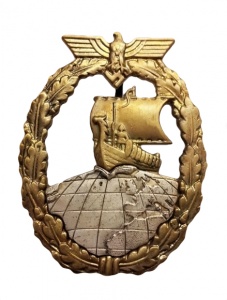HMAS Sydney (II) - Part 2
| Class |
Modified Leander Class |
|---|---|
| Type |
Light Cruiser |
| Pennant |
D48 |
| Builder |
Swan, Hunter and Wigham Richardson Ltd, Wallsend on Tyne, England |
| Laid Down |
8 July 1933 |
| Launched |
22 September 1934 |
| Commissioned |
24 September 1935 |
| Decommissioned |
19 November 1941 |
| Fate |
Lost in action on 19 November 1941 |
| Dimensions & Displacement | |
| Displacement | 7250 tons standard |
| Length | 555 feet overall |
| Beam | 56 feet 8 inches |
| Performance | |
| Speed | 32.5 knots |
| Complement | |
| Crew | 645 |
| Propulsion | |
| Horsepower | 72,000 |
| Armament | |
| Guns |
|
| Torpedoes | 8 x 21 inch torpedo tubes ( in 2 quadruple mounts) |
| Awards | |
| Inherited Battle Honours | |
| Battle Honours | |
During Sydney's passage home she passed through the Suez Canal and escorted several small convoys through the Red Sea before entering the Indian Ocean. There she conducted a sweep past Mogadishu, Somalia, looking for Italian vessels before proceeding independently to Fremantle where she arrived on 5 February to be greeted by a large contingent of the media, photographers and well wishers. Disappointingly for those onboard, the visit was short lived as she sailed the same afternoon for Sydney, having taken on stores and fresh provisions as well as embarking a small group of reporters and their camera men.
Sydney arrived in her namesake harbour shortly before midnight on Sunday 9 February 1941, anchoring in Watsons Bay. The following morning she weighed anchor and slowly made her way down the harbour towards her assigned berth at Circular Quay, amidst an escort of scores of motor launches carrying excited relatives and friends.
Admiral Cunningham’s hope that the men of Sydney would "get the reception they deserved" was certainly fulfilled, for when the cruiser arrived at the quay she was met by a huge crowd of people who had come to greet her. Many VIPs had also assembled to welcome Sydney home, including the Governor-General, Lord Gowrie, the Minister for the Navy, Billy Hughes and the First Naval Member Sir Ragnar Colvin. Following an addresses from them the crew of Sydney went ashore where they were embraced by their friends and families. News of Sydney’s arrival home dominated the newspapers which covered her return in detail over the next three days, making much of her triumphant return home.
On Tuesday 11 February, the Premier of New South Wales Mr Mair and the City of Sydney Lord Mayor, Alderman Crick came on board the cruiser to present a plaque to the ship commemorating her victory over the Bartolomeo Colleoni on behalf of the citizens of Sydney. The plaque consisted of two large cast medallions mounted on oak and was affixed to the gun housing of ‘Y’ turret below the sighting ports. With the unveiling of the plaque completed, the crew was fallen in on the quay side behind Sydney’s band and they then marched through the streets of Sydney to a civic reception which had been arranged for them at the Town Hall.
Thousands of people turned out to watch the men parade through the city and children were given the day off school so that they too could enjoy the celebration. At the Town Hall, each member of Sydney’s crew was presented with a smaller medallion of the same design as that awarded to the ship, all of which were individually inscribed with the recipient’s personal details.
For many of those present it was a day never to be forgotten. The victorious Sydney had come home at a time when the threat to Australian shipping in both the Pacific and Indian Oceans was increasing. Evidence that German raiders had been active around the Australian coastline was also mounting, indeed Bass Strait and the entrance to Port Phillip Bay had both been mined by raiders, and pressure had been brought to bear on the Government to bring the RAN’s big ships home to deal with the mounting threat.
Sydney’s return was both timely and symbolic. The Government had not only heeded the call, but had brought home the battle hardened Sydney. In the eyes of the Australian public, all would be well now that Sydney was home - none would have believed that in less than a year she would be gone, taking all those onboard with her.
The Australia Station
With the excitement surrounding Sydney’s return abating, and with censorship reapplied to her movements, the Navy turned its attention toward more practical matters, sending Sydney into dry dock for maintenance while her crew was sent on leave.
On 28 February, with her docking completed, the cruiser sailed from Sydney for Fremantle where she began a period of routine convoy escort duties operating off the Western Australian coast. In April she returned to the eastern seaboard escorting the troopship Queen Mary to Jervis Bay before undertaking a high speed passage via Fremantle to Singapore to carry the First Naval Member to a high level Allied conference. While in Singapore it was decided that Captain Collins would be appointed the Australian Naval Representative to the Commander-in-Chief China (based in Singapore) Vice Admiral (Sir) Geoffrey Layton.
And so it was that in Fremantle on 15 May 1941, 'Colleoni John', as he had been nicknamed by his crew, handed over command of Sydney to Captain Joseph Burnett, RAN. In later years, following a long and distinguished career in the RAN, Collins reflected:
To me there has never been before nor will there ever be again, a ship quite to compare with the cruiser Sydney of World War II.
Like Collins, Joseph Burnett had entered the Royal Australian Naval College as one of the original entry of cadets in 1913. He was rated cadet-captain in 1914 and went on to specialize in gunnery. He served in HMAS Australia during World War 1 and a number of Royal Navy vessels between the wars which included service abroad during the Spanish Civil War. Promoted to captain in 1938 he was serving in England when war broke out and returned home in late 1939 to take up the appointment of Assistant Chief of Naval Staff.
Burnett took his new command to sea for the first time between 17-21 May to conduct routine patrols and exercises in the Indian Ocean. On 26 May, Sydney relieved HMAS Hobart as the escort for the troopship Zealandia which was making an easterly passage from Melbourne to Singapore via Fremantle. After a short stop-over in Fremantle the two vessels continued their voyage on 31 May and arrived in the vicinity of the Sunda Strait on 6 June. There Sydney was relieved by HMS Danae before returning independently to Fremantle where she arrived four days later.
Zealandia was to become a familiar sight to the men of Sydney as her next assignment was to provide escort for the troopship during her return passage from the Sunda Strait to Fremantle later in the month. On 24 June, Zealandia was again under Sydney’s watchful eyes as part of a small convoy designated FS1 taking passage across the Great Australian Bight bound for Melbourne and Sydney respectively.
A change of scenery came in July when Captain Burnett and his crew escorted the Berwickshire and Gleniffer to New Zealand before conducting a resupply run to Noumea. She returned to Sydney on 25 July to escort convoy US 11B to Melbourne and after an intermediate docking in early August was again crossing the Tasman Sea bound for Auckland, New Zealand as escort for the Awatea. Following a three day stopover, the two vessels sailed on 14 August for Suva where they arrived a few days later. Sydney returned home independently on 28 August having escorted the Awatea beyond Samoa.
Meanwhile in the far distant Indian Ocean there had been a number of disturbing developments. Reports of spurious wireless signals coupled with the unexplained disappearance of several merchant ships had raised concerns that their might be a raider at large. This was indeed the case.
The German Navy’s largest auxiliary cruiser, the Kormoran, now disguised as the Dutch merchant ship MV Straat Malakka, had entered the Indian Ocean some months previously and was making her presence felt throughout the region. Adept at subterfuge and with a well drilled and disciplined crew she was more than a match for any unsuspecting merchant ship. Her captain, Kapitän zur See Theodor Anton Detmers, however, had no desire to encounter a warship from what he termed Australia’s ‘grey funnel’ line.
On 4 September, Sydney sailed from Port Jackson in company with the large troop transport Queen Mary. Picking up the Queen Elizabeth en route, the three vessels later rendezvoused with HMAS Canberra which assumed responsibility for their safe passage to Fremantle. Sydney then called at Melbourne to refuel and make good minor defects.
Her next voyage, escorting convoy U.S.12B to Fremantle would see Sydney leave the eastern seaboard for the last time. Never again would she sail through Sydney Heads, never again would she pass the mast of her forebear and never again would she be feted by the citizens of the city whose name she carried. As she shepherded her convoy west, her date with destiny was fast approaching as the Kormoran slowly made her way east towards the Western Australian coast.
Sydney arrived in Fremantle on 25 September and three days later continued on with U.S.12B on the now familiar route to the Sunda Strait where she was relieved by HMS Glasgow. Many of Sydney’s crew viewed this work as being a ‘milk run’ in comparison to the high tempo operations in the Mediterranean, yet there were subtle signs starting to appear, leading some to believe that things were not as benign as they appeared.
One of these signs came on the evening of 3 October when Sydney sighted an object floating on the sea, which on investigation appeared to be a large gunnery target. The wooden structure was recovered by one of Sydney’s boats and hoisted on board where it was examined and dismantled. Captain Burnett reported the discovery to Naval Headquarters in Melbourne stating that it was ‘difficult to find an explanation of this large structure which fitted all the facts’. He went on to express ‘that there is just a possibility that it may have been dropped by a raider’.
Days later an unidentified vessel was sighted by HMAS Yandra eight miles from Rottnest Island in the early hours of the morning of 6 October. The vessel melted into the darkness and in spite of an air search, no trace of it was found. Speculation concerning the identity of the vessel became the subject of considerable attention in the Combined Operations Intelligence Centre summaries over the next few days which again raised the possibility that a raider may have been operating in the area. As a precaution, minesweepers were ordered to operate ahead of Queen Mary and Sydney, both of which were due to arrive in Fremantle, while anti-submarine patrols were maintained during daylight hours.
Over the next few weeks Sydney conducted exercises off the Western Australian coastline and conducted short visits to Geraldton and Bunbury. Throughout 1941, Sydney had become a familiar sight in Western Australian waters and with each visit the bonds between the cruiser and the citizens of Western Australia were further strengthened.
On 1 November Sydney sailed from Fremantle to again rendezvous with Zealandia which was on passage from Melbourne with HMAS Adelaide as her escort. Sydney relieved Adelaide off King George’s Sound, Albany, before escorting the troop ship to Fremantle where they arrived on 9 November. Two days later Sydney sailed with Zealandia on the familiar ‘milk run’ to the Sunda Strait, signalling shore authorities before she sailed that she would return to port in the PM of Thursday 20 November.
Sydney’s passage to the Sunda Strait was without incident and at noon on 17 November she rendezvoused with HMS Durban which assumed responsibility for escorting Zealandia on to Singapore. Relieved of her escort duty, Sydney reversed course and resumed the now well-worn navigational track that would take her back to Fremantle.
As she disappeared over the horizon, none of those watching in Zealandia or Durban suspected that they would be among the last to see her and that it would be a further sixty-six years before friendly eyes once more gazed upon the pride of the Royal Australian Navy.*
*Author John Perryman courtesy David L Mearns, 'The Search for the Sydney, How Australia's Greatest Maritime Mystery was Solved', Harper Collins, Sydney, 2009.
Loss of HMAS Sydney
Sydney sailed from Fremantle on Armistice Day, 11 November, 1941 to escort the troopship Zealandia to Sunda Strait where she was to be relieved by the British cruiser HMS Durban for the last leg of the voyage to Singapore. The voyage was without incident and at noon on the 17 November Zealandia was turned over to Durban and Sydney then proceeded back to Fremantle where she was expected to arrive on the afternoon of 20 November 1941. She did not arrive as expected and the District Naval Officer, Western Australia, reported accordingly to the Naval Board at 11:00am the following day that Sydney was overdue. This did not immediately concern the Naval Board as they had been advised that Zealandia had arrived later than anticipated and it was assumed that Sydney too had been delayed. There was also the possibility that she might have diverted for another purpose and had not broken radio (wireless telegraphy) silence. When, however, she had not returned by 23 November, she was instructed by the Naval Board to report by signal. There was no reply.
The reconstruction of events leading up to Sydney's disappearance relies primarily on information gathered from interrogations of German survivors from the raider HSK Kormoran which Sydney engaged on the afternoon of 19 November 1941. The following is an account of Sydney's final action and subsequent loss based on surviving records, extensive research and the findings of a Chief of Defence Force inquiry concerning the loss of Sydney released in July 2009. Times reflected in this narrative are in G time zone (UTC+7) as recorded by the Germans.
Returning from her convoy duties to Java, Sydney was proceeding south along the north west coast of Western Australia when she sighted what appeared to be a merchant vessel at about 16:00 on 19 November 1941, some 130 miles west of Shark Bay.
The ship was in fact the Kormoran. Sydney challenged the vessel continuously using her searchlight while at the same time closing the range between the two ships. Merchant vessels were known to be less efficient at visual signalling and the Germans exploited this knowledge through their actions on their flag deck and by their slow response to Sydney's visual challenges. At 17:00, to further the deception, Kormoran broadcast a 'suspicious ship' message, feigning a cry for help in the name of Straat Malakka.
Sydney's efforts to establish the true identity of the vessel resulted in her closing the range to a point where she no longer had the advantage of her superior armament. At approximately 17:15 Sydney had drawn almost abeam of Kormoran to starboard, less than a mile distant. Both ships were steering west south west at about 15 knots. Still wary, the Australian cruiser kept her main armament trained on the mysterious ship and her amphibious aircraft was on the catapult with its engine running. She then signalled, both by flags and flashing light; 'Where bound?' Kormoran replied 'Batavia'. The crucial moment then came when Sydney hoisted a two flag signal consisting of the letters 'IK' which the raider could not interpret. They were in fact the two centre letters of the Straat Malakka's four letter secret identification signal (IIKP). With no reply forthcoming Sydney signalled in plain language 'Show your secret sign'.
Finally, when concealment of his vessel's true identity was no longer possible, and with the advantage of surprise, Detmers ordered the Dutch colours to be struck, hoisted the German naval ensign and opened fire at approximately 17:30 with all armament at a range 'somewhat more than a mile'.
It is likely that the raider's first salvo destroyed Sydney's bridge, with the result that her primary control was immediately put out of action. Sydney's own guns opened fire almost simultaneously with a full salvo that passed over Kormoran without inflicting damage. Kormoran again scored hits on Sydney with two salvos again hitting her bridge and midships section. According to the Germans all of Kormoran's armament was brought to bear on Sydney, concentrating on her bridge, torpedo tubes and anti aircraft batteries.
For a few seconds after her initial salvo Sydney did not reply. It appears that her forward 'A' and 'B' turrets were put out of action leaving only her after turrets 'X' and 'Y' to respond. It was reported by the Germans that Sydney's 'X' turret opened fast and accurate fire, hitting Kormoran in the funnel and engine room. 'Y' turret is said to have fired only two or three salvos, all of which went over. At about this time one of the raider's two torpedoes struck Sydney under 'A' and 'B' turrets. The other passed close ahead of the stricken ship, which was subjected to enfilading fire.
With her bow low in the water, Sydney then turned sharply towards Kormoran as though attempting to ram. As she did so, the top of 'B' turret was blown off and flew overboard, the cruiser then passed under Kormoran's stern, heading to the southward and losing way. Kormoran, maintaining her course and speed, was now on fire in the engine room where hits by Sydney's 'X' turret had caused severe damage. Smoke from the fire hid Sydney from Kormoran's bridge but the raider continued to engage with her after guns as the range opened to approximately 4400 yards.
At about 17:45 Sydney was seen to fire a torpedo when Detmers was turning his ship to port to bring his broadside to bear, however, as he did so Kormoran's engines began to fail. The torpedo track was sighted and it was subsequently avoided. Simultaneously the raider's engines broke down completely.
Sydney, crippled and on fire from the bridge to the after funnel, steamed slowly to the south returning only sporadic fire from her secondary armament. Although by now the range had opened to 6600 yards Sydney continued to receive steady hits from Kormoran's port broadside. At 18:00, at a range of 7700 yards, Kormoran then fired one torpedo that missed Sydney's stern. Although this fierce action had lasted only half an hour both ships had been dealt mortal blows.
Kormoran fired her last shot at 18:25 at a range of about 11,000 yards. The Germans claim to have fired approximately 450 rounds from her main armament and hundreds from her anti-aircraft batteries. With the gathering gloom the form of Sydney disappeared from view and was last seen by the Germans about ten miles off, heading approximately south south east. Thereafter, until about 22:00, all that was seen was a distant glare then occasional flickerings until midnight at which time all trace of Sydney disappeared.
Of Sydney's total complement of 42 officers and 603 ratings, none survived. This number included six members of the Royal Australian Air Force and four civilian canteen staff. The only significant material evidence recovered from Sydney was an Australian naval type Carley life float recovered eight days after the action by HMAS Heros and an Australian naval pattern lifebelt recovered by HMAS Wyrallah. The Carley float found by Heros is now preserved in the Australian War Memorial in Canberra. On 6 February 1942 a second Carley Float washed ashore at Christmas Island carrying the body of a naval rating. This fascinating chapter of Sydney's story is covered in Part 6 of this ship history entry.
Note: This video is hosted on YouTube. Department of Defence users will not be able to view this video on the Defence Protected Network.
This cine film has been placed online as part of the Sea Power Centre - Australia's ongoing archival digitisation program.
Kormoran survivors
The order to abandon Kormoran was given by Detmers between 20:00-21:00 and all accessible life saving equipment in the fire free portion of the ship was put overboard. At this period some 380 officers and men remained alive. Almost all the officers and enough ratings to man the guns, waited on board while the final scuttling arrangements were made. Remaining life saving equipment consisted of two steel boats located forward in No. 2 hold, however damage to the ship delayed the launching of these.
At midnight, with smoke increasing heavily on the mining deck, the scuttling charge was fired, and the last boat cast off. Half an hour later at 00:35 the mines carried by Kormoran exploded and she sank rapidly stern first. During the final abandonment a large rubber boat sank without warning, throwing some 60 men into the sea who drowned.
At 17:00 (Western Australian time) on 24 November 1941 the British tanker Trocas bound Palembang for Fremantle reported by W/T (wireless telegraphy) the rescue of 25 German seamen from a raft sighted some 115 miles west north west of Carnarvon. This was the first positive evidence of a possible naval engagement involving the overdue Sydney. Naval authorities immediately despatched four RAN auxiliary craft with armed guards on board to rendezvous with Trocas. At the time of receipt of the signal from Trocas air searches seeking Sydney were already in progress.
Unbeknown to the naval authorities the transport Aquitania, had also sighted a raft and rescued 26 Germans the previous day (23 November). Maintaining W/T silence her command passed on no information of this until 27 November, when she informed the signal station at Wilsons Promontory of her discovery.
The air searches produced their first results early on the morning of 25 November. At 07:00 a lifeboat was sighted north north west of Carnarvon. Further sightings during the day revealed up to five boats in the area at that time.
Eventually two boats, those commanded by Lieutenant Commander Henry Meyer and Chief Petty Officer Paul Kohn came ashore unaided some 50 and 70 miles north of Carnarvon respectively. Organised land parties were despatched and apprehended these groups during the afternoon of their landing. The Steamer Koolinda picked up a third boat, Centaur one (containing Detmers) and HMAS Yandra one. Based on records made at the time the total number of Kormoran survivors rescued was as follows:
| Trocas | One rubber raft | 25 men | landed Fremantle |
| Aquitania | One rubber raft | 26 men | landed Sydney |
| Centaur | One lifeboat | 60 men | landed Carnarvon |
| Koolinda | One lifeboat | 31 men | landed Carnarvon |
| Yandra | One lifeboat | 72 men | landed Carnarvon |
| One lifeboat | 57 men | landed north of Carnarvon | |
| One lifeboat | 46 men | landed north of Carnarvon | |
| Total of 317 men, including two Chinese |
Kormoran statistics
| Type | Auxiliary Raider G Ship 41 Kormoran (formerly the Hamburg-Amerika Line ship Steirmark) |
| Displacement | 8736 tons |
| Length | 515 feet |
| Beam | 66 feet |
| Builder | Kiel Shipyards |
| Speed | 18 knots |
| Armament | 6 x 15cm (5.9-inch) guns. Range 18,100 yards |
| 5 x 2cm anti-aircraft guns | |
| 2 x 3.7cm anti-aircraft guns | |
| 6 x 21-inch torpedo tubes (two below the waterline) | |
| Capable of carrying approximately 360 mines | |
| Aircraft | 2 x Arado 196 float planes stowed in No. 5 hold |
| Complement | 400 |

